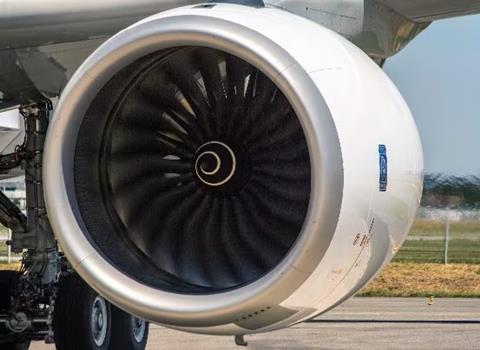Rolls-Royce has revealed more detail on the hot-section improvements it is making to its Trent-series widebody engine family as it targets better durability and time-on-wing, particularly in hot and sandy operating environments.
Part of a £1 billion ($1.3 billion) technology insertion programme first disclosed in February, the enhancements will be applied to the Trent XWB-97 for the Airbus A350-1000, the Trent 7000 for the A330neo and the Trent 1000 – an option on the Boeing 787.

Simon Burr, Rolls-Royce group director of engineering, says that fuel-burn improvements achieved by all engine manufacturers in recent years have “been won in general at the expense of durability” and “that’s a balance that has to be corrected”.
Numerous technologies matured through the UltraFan demonstrator will be incorporated onto the company’s in-production engines as it strives to deliver a step-change in durability.
Burr says that, despite the 97,000lb-thrust (430kN) Trent XWB-97’s high dispatch reliability, “in hot and sandy environments it’s not as durable as it should be. So we have focused our efforts on addressing that.”
Forming the largest part of the overall investment, Rolls-Royce has embarked on a three-phase programme for the engine. An initial step – already in service – has seen the company increase the temperature margin on hot-section components and improve the turbine case cooling.
Phase two will see the introduction of so-called CMAS-resistant coatings – those impervious to the effects of sand – to high-pressure turbine (HPT) seals. Parts featuring the enhancement are already in production and will enter service later this year.
Lastly, Rolls-Royce will, from 2028, incorporate additional modifications to the HPT components which promise a “huge step-change in life – even in the Middle East”.
Revised HPT blades to enhance cooling will be introduced, alongside the addition of ceramic matrix composite (CMC) material to the HPT seal, improving the interface between the two parts.
“We discovered it was running hotter at this interface than we originally modelled, that’s why we are introducing CMC technologies,” says Burr.
“We feel very comfortable with what we are doing there, but industrialising that is a chunk of what we are investing in at the moment.”
Updates to the combustor will also be fielded, which will present the turbine blade with a more uniform thermal profile, again increasing longevity.
Extensive component and engine testing has been performed, including dust-ingestion rig testing using sand formulated to match that found in the Middle East, down to grain size and chemical composition.
Although Burr stresses the enhancements have been in development for several years, they should go some way to addressing complaints voiced at last November’s Dubai air show by Emirates Airline president Sir Tim Clark, who said the carrier would not order A350-1000s until engine durability concerns were solved.
Upgrades to the XWB-97 will be incorporated into all new-build engines and retrofitted to the in-service fleet during overhauls.

Meanwhile, Rolls-Royce is working on a further improvement to the Trent 7000, having already brought in a “very significant durability update” in September 2022, which has “nearly doubled” time-on-wing in all environments.
The manufacturer will towards the end of 2024 begin testing a further enhancement to “crank up” durability by another 30%, says Burr.
“And we have a whole load of other technologies in our armoury from the work done on UltraFan which we can bring to bear.”
However, improvements to the Trent 1000 cannot come soon enough. Burr acknowledges the “difficult story” on the powerplant, noting that it has “lost market share” against the competing GE Aerospace GEnx “because it’s not sufficiently durable”.
“It is incredibly frustrating for Rolls-Royce because the parts we are changing on this engine are identical to the ones we have changed on the Trent 7000. It’s the same core turbomachinery and we know the change works.”
The modifications were certificated by the European regulator earlier this year, but flight-testing using a 787 is required before the improved version can enter service. That is scheduled to begin in August and should last around eight weeks.
“Then it can go into service and provide relief to the people that operate the Trent 1000 and give them the same step change in durability that we have seen on the 7000.”
Additionally, the propulsion specialist is closing in on validation for another upgrade – previously known as the Enhanced Performance, or EP version – for the XWB-84 which should deliver a 1% improvement in specific fuel consumption. The EP was launched in 2016 with an order from Singapore Airlines with an original service-entry target of late 2019.
Certification will be achieved later this year for service entry in 2025, with production of the first serial engine already under way. Although Rolls-Royce has set a target to improve SFC by 1% “actually the engine is performing much better than that in flight”, says Burr.
Over 100 flights have been performed so far using an A350-900 test aircraft, he adds. “It’s a step up from where we are today. We feel very good about this.”
The better fuel-burn performance has been enabled by revisions to the fan and aerodynamic design to deliver improved compressor efficiency. Turbine blade cooling has also been enhanced.
However, the changes are too significant to allow their retrofit to in-service engines, with the lower SFC variant only available as an option, rather than standard fit, on new-build jets.
Rolls-Royce also plans a second step through which it will introduce turbine discs made from a new proprietary superalloy – branded RR1073 – originally developed for the UltraFan programme.
Burr says components cast from the nickel-based superalloy have a more predictable lifespan and can withstand temperatures around 50 Kelvin hotter than the current RR1000 material.
Turbine discs using the material have already been built and will be introduced to both the XWB-84 and -97 next year.































